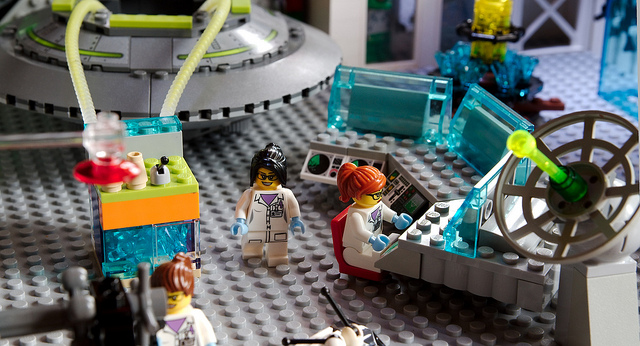You have /5 articles left.
Sign up for a free account or log in.
Travis Grandy is a PhD student in Composition and Rhetoric at the University of Massachusetts Amherst. You can find him on Twitter @travisgrandy or at his website.

Teaching research as a team-based activity is probably old hat to those of you in STEM, but in the humanities, many of us still cling to the solitary research process of toiling away in some dark library corner. I, for one, was feeling fed-up—I often saw students become overwhelmed and disengaged by a complex research process, and I would have to answer the same questions about doing research to each individual student.
This semester, while teaching a 200-level English seminar on tutoring writing, and with some help from my advisor, I took a different approach: instead of setting students up for the conventional research paper, I structured my class around a collaborative research process. I was considering incorporating more flipped elements into my teaching, and wanted the learning activities in my class to better reflect my course outcomes. In particular, I wanted students to experience how our field generates knowledge by doing it themselves—I required students to get their hands dirty by doing primary research, I scaffolded assignments so that each could build up to the final paper, and I had students form teams based on their research interests. Now, I’m the first to admit that this approach was far from perfect, but the feedback I got from my students was positive and I’d definitely teach this way again. As you head into summer and start revising syllabi for next fall, I hope these takeaways can help you think of ways collaborative projects can make your classes more engaging and fun to teach.
1. Get their (and your) hands dirty: As a child of the 90s, I readily ascribe to the Ms. Frizzle method of inquiry (i.e. “Take chances, make mistakes, and get messy”). My class was about the methods and theories of tutoring writing, but I wanted my students to walk away with a sense of how scholars in this field actually conduct research in order to create theory (See R. Mark Hall). I started by curating assigned readings that would help students identify conversations in the field. Also, I purposely assigned readings from journals that publish work by undergraduates so that students could identify places where they could join in (and potentially publish). The other major change was to directly engage students in conducting primary research. Rather than having students form arguments based on secondary sources, I wanted them to try to collect information first-hand. Your field is probably has its own way of approaching this, but for my students this meant doing some kind of observational, interview, or survey-based research. As I’ll get to a little later, students didn’t go through this process alone, but instead had a chance to practice and reflect with the support of their groups.
2. Design your course backwards: If I wanted this research process to be successful, I knew that my major assignments needed to support my course outcomes, so I decided to plan backwards. In the end I knew that I wanted students to combine their primary research with personal reflection in order to enter an existing scholarly conversation. I planned class activities around incremental steps of the research process, and specifically the genres of writing that would provide some structure for each step. Prior to forming their research groups I had students writing weekly reflections on our course blog. Next, I had students form groups based on their intersecting interests and collaborate on a literature review to better understand the main ideas or questions being pursued in their subject area. As groups, students then developed research questions and collected primary data. Next they wrote an experimental report, a summary of the questions driving their research, rationale for the methods they used to collect information, and a discussion of the implications of what they observed. Lastly, students brought all these parts together in a synthesis, to offer an insight or argument relevant to an audience in our field. I felt this scaffolding was really helpful because it did two things: first, it broke down the entire research process into discrete parts, meaning students wouldn’t have to tackle the entire process at once; second, the process was necessarily spread out over several weeks, giving students time to test ideas, troubleshoot, and most importantly, revise.
3. Support groups consistently: While nobody in the class was an expert researcher (including me), I knew that through collaborating, students could piece together the parts they knew and then problem-solve together. For example, one student shared that the group process “helped [him] feel more comfortable and less overwhelmed about the task of gathering research.” However, I also knew that they couldn’t do this without support, so I made sure to dedicate in-class time for groups to convene. In addition, I planned activities that would help practice skills they would use later. Prior to the major assignments we would practice research skills in small groups—we deconstructed a sample essay prior to writing a literature review, and we practiced interview and observation skills through class activities like peer review. I also structured assignments so that each group member would have something to contribute: for the lit review, group members were assigned to summarize a specific number of secondary sources and then the entire group had to organize these summaries into a coherent review; for the experimental report, group members were expected to share their data so that groups didn’t need to duplicate work. When it came time to give feedback on group papers, I scheduled a conference with each group. It ended up being a economical way to share verbal and written feedback with students, as well as a chance to support the group as they planned the next stage of their research.
If I were to do it all over again, I’m confident that I would stick with the group research process, if at the very least because my students found it incredibly helpful and it was a lot of fun for me teach! In feedback, one student shared that “being able to collaborate with peers not only helped [him] feel more relaxed, it helped the project grow immensely.” He went on to say that he appreciated how each group member brought their own approach, and “allowing all of those perspectives into the conversation prevented [their] project from becoming too narrow.” Like I mentioned earlier, the process didn’t go perfectly, and due to a number of factors I had to tweak things over the course of the semester. In the future, I would try to stretch the research process out even longer (it ended up taking the last six weeks of my course). This doesn’t mean the research process needed to take over the entire class, but by more evenly distributing the research tasks, students would have time to reflect and connect research skills to the other texts we were reading (approaching texts as researchers got them thinking about “how it’s made”). Second, I think groups would have benefitted from some peer evaluation, especially after writing a collaborative paper. Any sort of group project has challenges as people try to align their working styles, and creating space for feedback is a good way to help students reflect on how they communicate and support their peers.
What approaches do you bring to engaging your students in the research process? Have any tips for helping groups be successful? Tell us in the comments!
[Photo by Flickr user Paul Albertella and used under Creative Commons License]








